Yellow badge
Yellow badges (or yellow patches), also referred to as Jewish badges (German: Judenstern, lit. 'Jew's star'), are badges that Jews were ordered to wear in public during periods of the Middle Ages by the ruling Christians and Muslims, and in Nazi Germany. The badges served to mark the wearer as a religious or ethnic outsider, and often served as a badge of shame.[1]
Usage
Islamic world
The practice of wearing special clothing or markings to distinguish Jews and other non-Muslims (Dhimmis) in Muslim-dominated countries seems to have been introduced in the Umayyad Caliphate by Caliph Umar II in the early 8th century. The practice was reissued and reinforced by Caliph Al-Mutawakkil (847–861), subsequently remaining in force for centuries.[2][3] A genizah document from 1121 gives the following description of decrees issued in Baghdad:
Two yellow badges [are to be displayed], one on the headgear and one on the neck. Furthermore, each Jew must hang round his neck a piece of lead with the word Dhimmi on it. He also has to wear a belt round his waist. The women have to wear one red and one black shoe and have a small bell on their necks or shoes.[4]
Medieval Catholic Europe
In largely Catholic Medieval Europe, Jews and Muslims were required to wear distinguishable clothing in some periods. These measures were not seen as being inconsistent with Sicut Judaeis. Although not the first ecclesiastic requirement for non-Christians to wear distinguishable clothing, the Fourth Council of the Lateran headed by Pope Innocent III ruled in 1215 that Jews and Muslims must wear distinguishable dress (Latin habitus). Canon 68 reads, in part:
In some provinces a difference in dress distinguishes the Jews or Saracens from the Christians, but in certain others such a confusion has grown up that they cannot be distinguished by any difference. Thus it happens at times that through error Christians have relations with the women of Jews or Saracens, and Jews and Saracens with Christian women. Therefore, that they may not, under pretext of error of this sort, excuse themselves in the future for the excesses of such prohibited intercourse, we decree that such Jews and Saracens of both sexes in every Christian province and at all times shall be marked off in the eyes of the public from other peoples through the character of their dress. Particularly, since it may be read in the writings of Moses [Numbers 15:37–41], that this very law has been enjoined upon them.[5]
Innocent III had in 1199 confirmed Sicut Judaeis, which was also confirmed by Pope Honorius III in 1216. In 1219, Honorius III issued a dispensation to the Jews of Castile,[6] the largest Jewish population in Europe. Spanish Jews normally wore turbans, which presumably met the requirement to be distinctive.[7] Elsewhere, local laws were introduced to bring the canon into effect.[8] The identifying mark varied from one country to another, and from period to period.
In 1227, the Synod of Narbonne, in canon 3, ruled:
That Jews may be distinguished from others, we decree and emphatically command that in the center of the breast (of their garments) they shall wear an oval badge, the measure of one finger in width and one half a palm in height ...[5]
However, these ecclesiastic pronouncements required legal sanctions of a temporal authority. In 1228, James I of Aragon ordered Jews of Aragon to wear the badge;[6] and in 1265, the Siete Partidas, a legal code enacted in Castile by Alfonso X but not implemented until many years later, included a requirement for Jews to wear distinguishing marks.[9] On 19 June 1269, Louis IX of France imposed a fine of ten livres (one livre was equivalent to a pound of silver) on Jews found in public without a badge (Latin: rota, "wheel", French: rouelle or roue).[6][10] The enforcement of wearing the badge is repeated by local councils, with varying degrees of fines, at Arles 1234 and 1260, Béziers 1246, Albi 1254, Nîmes 1284 and 1365, Avignon 1326 and 1337, Rodez 1336, and Vanves 1368.[6] The "rota" looked like a ring of white or yellow.[11] The shape and colour of the patch also varied, although the colour was usually white or yellow. Married women were often required to wear two bands of blue on their veil or head-scarf.[12]
In 1274, Edward I of England enacted the Statute of Jewry, which also included a requirement:
Each Jew, after he is seven years old, shall wear a distinguishing mark on his outer garment, that is to say, in the form of two Tables joined, of yellow felt of the length of six inches and of the breadth of three inches.[13][14]
In German-speaking Europe, a requirement for a badge was less common than the Judenhut or Pileum cornutum (a cone-shaped head dress, common in medieval illustrations of Jews). In 1267, in a special session, the Vienna city council required Jews to wear a Judenhut; the badge does not seem to have been worn in Austria.[15] There is a reference to a dispensation from the badge in Erfurt on 16 October 1294, the earliest reference to the badge in Germany.[6]
There were also attempts to enforce the wearing of full-length robes, which in late 14th century Rome were supposed to be red. In Portugal a red star of David was used.[16]
Enforcement of the rules was variable; in Marseilles the magistrates ignored accusations of breaches, and in some places individuals or communities could buy exemption. Cathars who were considered "first time offenders" by the Catholic Church and the Inquisition were also forced to wear yellow badges, albeit in the form of crosses, about their person.
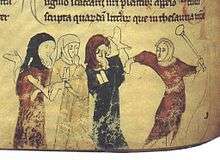 Jews being beaten, from an English manuscript.
Jews being beaten, from an English manuscript.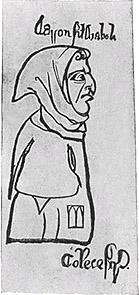
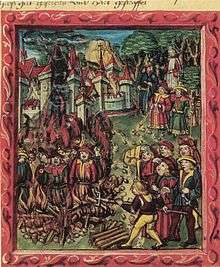 Jews (identifiable by rouelle) being burned at the stake. From medieval manuscript.
Jews (identifiable by rouelle) being burned at the stake. From medieval manuscript.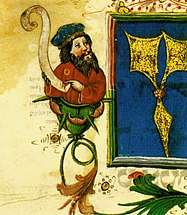 Jewish ring from a Hebrew Passover manuscript, German 15th century.
Jewish ring from a Hebrew Passover manuscript, German 15th century.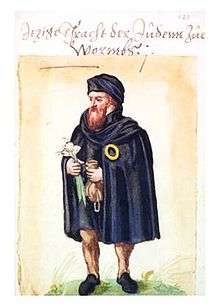 16th-century watercolour of a Jew from Worms, Germany. The rota or Jewish ring on the cloak, moneybag, and garlic bulb are symbols of antisemitic ethnic stereotypes.
16th-century watercolour of a Jew from Worms, Germany. The rota or Jewish ring on the cloak, moneybag, and garlic bulb are symbols of antisemitic ethnic stereotypes.
The yellow badge is different from the Jewish hat (or Judenhut), a cone-shaped hat, which is seen in many illustrations from before this date, and remained the key distinguishing mark of Jewish dress in the Middle Ages.[17] From the 16th century, the use of the Judenhut declined, but the badge tended to outlast it, surviving into the 18th century in places.[18]
Nazi Germany and Axis Powers

After the German invasion of Poland in 1939 there were initially different local decrees requiring Jews to wear a distinctive sign under the General Government. The sign was a white armband with a blue Star of David on it; in the Warthegau a yellow badge in the form of a Star of David on the left side of the breast and on the back.[19] The requirement to wear the Star of David with the word Jude (German for Jew) – inscribed in letters meant to resemble Hebrew writing – was then extended to all Jews over the age of six in the Reich and the Protectorate of Bohemia and Moravia (by a decree issued on September 1, 1941, signed by Reinhard Heydrich)[20][21] and was gradually introduced in other German-occupied areas, where local words were used (e.g., Juif in French, Jood in Dutch).
One observer reported that the star increased German non-Nazi sympathy for Jews as the impoverished citizens who wore them were, contrary to Nazi propaganda, obviously not the cause of German failure in the east. In the Protectorate of Bohemia and Moravia, government had to ban hat tipping toward Jews and other courtesies that became popular as protests against the German occupation. A whispering campaign that claimed that the action was in response to the United States government requiring German Americans to wear swastikas was unsuccessful.[22]
Timeline
Islamic world
- 717–720
- Caliph Umar II orders non-Muslims (dhimmi) to wear vestimentary distinctions (called giyār, i.e., distinguishing marks)
- 847–861
- Caliph Al-Mutawakkil reinforces and reissues the edict. Christians are required to wear patches. One of the patches was to be worn in front of the breast and the other on the back. They were required to be honey-colored.[23]
- 887/888
- Aghlabid governor of the Emirate of Sicily orders Jews to wear on their garments and put on their doors a piece of cloth in the form of donkey and to wear yellow belts and special hats.[3]
Medieval and Early Modern Europe
- 1215
- Fourth Lateran Council headed by Pope Innocent III declares: "Jews and Saracens of both sexes in every Christian province and at all times shall be marked off in the eyes of the public from other peoples through the character of their dress."[24]
- 1219
- Pope Honorius III issues a dispensation to the Jews of Castile.[6] Spanish Jews normally wore turbans in any case, which presumably met the requirement to be distinctive.[7]
- 1222
- Archbishop of Canterbury Stephen Langton orders English Jews to wear a white band two fingers broad and four fingers long.[6]
- 1227
- Synod of Narbonne rules: "That Jews may be distinguished from others, we decree and emphatically command that in the center of the breast (of their garments) they shall wear an oval badge, the measure of one finger in width and one half a palm in height."[24]
- 1228
- James I orders Jews of Aragon to wear the badge.[6]
- 1265
- The Siete Partidas, a legal code enacted in Castile by Alfonso X but not implemented until many years later, includes a requirement for Jews to wear distinguishing marks.[9]
- 1267
- In a special session, the Vienna city council forces Jews to wear Pileum cornutum (a cone-shaped head dress, common in medieval illustrations of Jews); the badge does not seem to have been worn in Austria.[15]
- 1269, June 19
- France. (Saint) Louis IX of France orders all Jews found in public without a badge (French: rouelle or roue, Latin: rota) to be fined ten livres of silver.[10] The enforcement of wearing the badge is repeated by local councils, with varying degrees of fines, at Arles 1234 and 1260, Béziers 1246, Albi 1254, Nîmes 1284 and 1365, Avignon 1326 and 1337, Rodez 1336, and Vanves 1368.[6]
- 1274
- The Statute of Jewry in England, enacted by King Edward I, enforces the regulations. "Each Jew, after he is seven years old, shall wear a distinguishing mark on his outer garment, that is to say, in the form of two Tables joined, of yellow felt of the length of six inches and of the breadth of three inches."[14]
- 1294, October 16
- Erfurt. The earliest mention of the badge in Germany.[6]
- 1315–1326
- Emir Ismail Abu-I-Walid forces the Jews of Granada to wear the yellow badge.[6]
- 1321
- Henry II of Castile forces the Jews to wear the yellow badge.[6]
- 1415, May 11
- Bull of the Antipope Benedict XIII orders the Jews to wear a yellow and red badge, the men on their breast, the women on their forehead.[6]
- 1434
- Emperor Sigismund reintroduces the badge at Augsburg.[6]
- 1528
- The Council of Ten of Venice allows the newly arrived famous physician and professor Jacob Mantino ben Samuel to wear the regular black doctors' cap instead of Jewish yellow hat for several months (subsequently made permanent), upon the recommendation of the French and English ambassadors, the papal legate, and other dignitaries numbered among his patients.[25]
- 1555
- Pope Paul IV decrees, in his Cum nimis absurdum, that the Jews should wear yellow hats.
- 1566
- King Sigismund II passes a law that required Lithuanian Jews to wear yellow hats and head coverings. The law was abolished twenty years later.[6]
- 1710
- Frederick William I of Prussia abolished the mandatory Jewish yellow patch in return for a payment of 8,000 thaler (about $75,000 worth of silver at 2007 prices) each.[26]
Nazi Germany and Axis Powers
1939
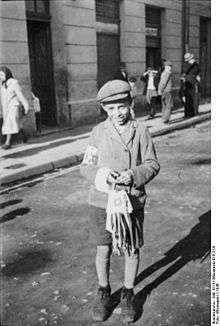
- September and October
- A number of local German occupational commanders ordered Jewish Poles in their areas to wear an identifying mark under the threat of death. There were no consistent requirements as to its color and shape: it varies from a white armband to a yellow Star of David badge.
- 23 November
- Hans Frank ordered all Jewish Poles above the age of 11 years in German-occupied Poland to wear white armbands with a blue Star of David.
1940
- A popular legend portrays king Christian X of Denmark wearing the yellow badge on his daily morning horseback ride through the streets of Copenhagen, followed by non-Jewish Danes responding to their king's example, thus preventing the Germans from identifying Jewish citizens. Queen Margrethe II of Denmark has explained that the story was not true.[27][28] No order requiring Jews to wear identifying marks was ever introduced in Denmark.[29]
1941
- June 4
- Jews in the Independent State of Croatia ordered to wear "Jewish insignia".[30]
- July
- Jewish Poles in German-occupied Soviet-annexed Poland, Jewish Lithuanians, Latvians and Estonians as well as Soviet Jews in German-occupied areas were obliged to wear white armbands or yellow badges.
- August 8
- All Romanian Jews were ordered to wear the yellow badge.[31]
- August 13
- The yellow badge was the only standardised identifying mark in the German-occupied East; other signs were forbidden.
- September 1
- Jewish Germans and Jews with citizenship of annexed states (Austrians, Czechs, Danzigers) from the age of six years were ordered to wear the yellow badge from September 19 when in public.[32]
- September 5
- In Luxembourg, the German occupation authorities introduce the Nuremberg Laws, followed by several other anti-Jewish ordinances including an order for all Jews to wear a yellow star with the word "Jude".[33]
- September 9
- Slovakia ordered its Jews to wear yellow badges.
- 1941/1942
- Romania started to force Jews in newly annexed territories, denied Romanian citizenship, to wear the yellow badge.
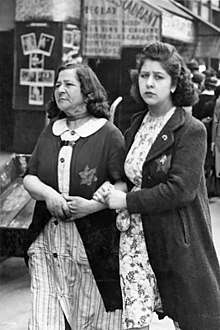
1942
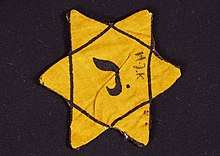
- March 13
- The Gestapo ordered Jewish Germans and Jews with citizenship of annexed states to mark their apartments or houses at the front door with a white badge.[34]
- April 29
- Jewish Dutch people ordered to wear the yellow badge.
- June 3
- Jewish Belgians ordered to wear the yellow badge.
- June 7
- Jews in occupied France, covering the northern and western half of the country, were ordered to wear a yellow star by the German authorities.
- August
- Under German pressure, Bulgaria ordered its Jewish citizens to wear small yellow buttons, but contravention was not prosecuted.
- November
- German forces invaded and occupied the Zone libre, i.e. the south-eastern half of France, but did not enforce the yellow star directive there.
1944
- April 7
- After the occupation of Hungary, the Nazi occupiers ordered Jewish Hungarians and Jews with defunct other citizenships (Czechoslovakian, Romanian, Yugoslavian) in Hungarian-annexed areas to wear the yellow badge.[35]
See also
References
- D'Ancona, Jacob (2003). The City Of Light. New York: Citadel. pp. 23–24. ISBN 0-8065-2463-4.
But the wearing of a badge or outward sign — whose effect, intended or otherwise, successful or not, was to shame and to make vulnerable as well as to distinguish the wearer…
- Antisemitism: A Historical Encyclopedia of Prejudice and Persecution, Volume 1 By Richard S. Levy P:779
- "Jewish Badge". www.jewishvirtuallibrary.org.
- Johnson, Paul (1987). A History of the Jews. Harper & Row. pp. 204–205. ISBN 978-0-06-015698-5.
- "Internet History Sourcebooks Project". sourcebooks.fordham.edu.
- "BADGE - JewishEncyclopedia.com". www.jewishencyclopedia.com.
- Norman Rose Archived 2008-10-24 at the Wayback Machine in Medieval Jewish Civilization: An Encyclopedia (Routledge)- "Jewish Clothing".
- Schreckenburg, Heinz, The Jews in Christian Art, pp. 15 and passim, 1996, Continuum, New York, ISBN 0-8264-0936-9.
- Medieval Sourcebook, Las Siete Partidas: Laws on Jews accessed 18-09-2006
- Eli Birnbaum. "This day in Jewish History". The Jerusalem Post. Retrieved 2006-08-09.
- Schreckenburg:15, although Piponnier and Mane, p. 137 say red was commonest for badges of all shapes, followed by yellow or green, or red and white together.
- Piponnier and Mane, p. 137.
- Schreckenburg: 305.
- "A Day in the Life of 13th Century England". BBC. Retrieved 2006-09-05.
- (Jewish Encyclopedia yellow badge op. cit)
- Françoise Piponnier and Perrine Mane; Dress in the Middle Ages; p. 137, Yale UP, 1997; ISBN 0-300-06906-5.
- Schreckenburg, Heinz, The Jews in Christian Art, p. 15, 1996, Continuum, New York, ISBN 0-8264-0936-9, although the Jewish Encyclopedia cites a reference from 1208 in France. See the Jewish Encyclopedia for the Judenhut being more widespread than the badge.
- Schreckenburg: 308–329.
- Encyclopedia of the Holocaust (at the Museum of Tolerance).
- (came into force September 19, 1941).
- "Buildings Integral to the Former Life and/or Persecution of Jews in Hamburg". Archived from the original on November 12, 2005.
- Smith, Howard K. (1942). Last Train from Berlin. Knopf. pp. 195–199, 203–204.
- al-Tabari (923). "Islam: Decree of Caliph al-Mutawakkil". Retrieved February 28, 2017.
- Fourth Lateran Council, Canon 68
- Jacob Mantino ben Samuel, (Jewish Encyclopedia)
- Amos Elon: The Pity of It All: A History of the Jews in Germany, 1743-1933 (Metropolitan Books, 2002) p.15. ISBN 0-8050-5964-4. See talk page for conversion.
- Anne Wolden-Ræthinge (1990) Queen in Denmark, Copenhagen: Gyldendal, ISBN 87-01-08623-5
- Did King Christian X of Denmark wear a yellow star in support of the Danish Jews? (USHMM Research Library). Accessed 2006-08-17.
- Gunnar S. Paulsson, "The Bridge over the Øresund", Journal of Contemporary History, June 1995.
- "Notice regarding the obligatory wearing of Jewish insignia and the marking of Jewish trades, stores and companies". Jasenovac Memorial Site. Retrieved 2014-01-16.
- Richard J. Evans, The Third Reich at War, 1939-1945, Penguin Books, 2008, p. 231
- Cf. Polizeiverordnung über die Kennzeichnung der Juden (police ordinance on the marking of Jews).
- "The Destruction of the Jews of Luxembourg". Holocaust Education & Archive Research Team. Holocaust Research Project. 2013. Retrieved 15 March 2018.
- Die Juden in Deutschland, 1933–1945: Leben unter nationalsozialistischer Herrschaft, Wolfgang Benz (ed.), Munich: Beck, 1988, ISBN 3-406-33324-9, pp. 618seq.
- Evans, Richard J. (2008) The Third Reich at War. New York: Penguin Books. p.616. ISBN 978-0-14-311671-4
External links
| Wikimedia Commons has media related to Yellow badge. |
- Distinctive Badges that Jews Were Forced to Wear During the Holocaust - Yad Vashem website
- The Jewish Badge at About.com
- Jewish medieval clothing - article by Norman Roth
- Origins of the Yellow Star -Ancient Islamic origin of the Yellow Star
- Yellow Badge in Art
- A Yellow Star of David Button, Which the Bulgarian Jews were Forced to Wear in 1941 with the Onset of the German Occupation from the Yad Vashem artifacts collection
- "Wear It With Pride, The Yellow Badge" by Robert Weltsch Juedische Rundschau, No. 27, April 4, 1933
Denmark: The king against the yellow badge
- Rescue of the Danish Jews at auschwitz.dk
- King of Denmark and yellow stars at Snopes.com's Urban Legend website
